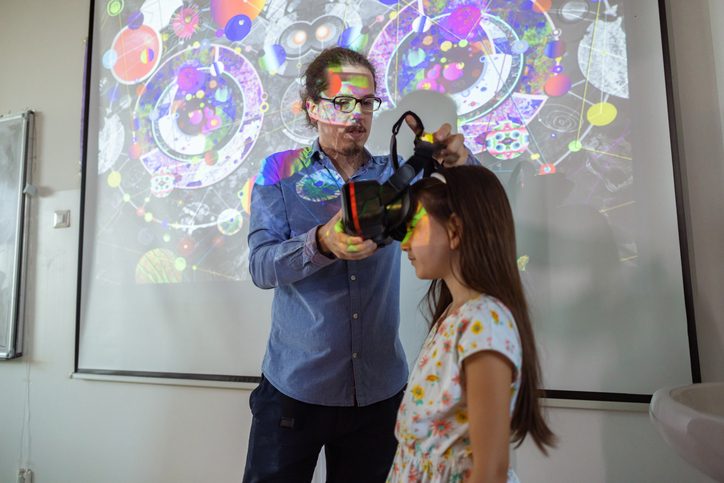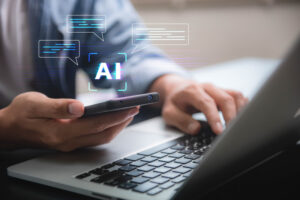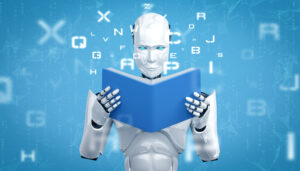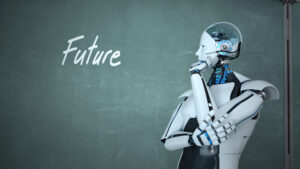Harnessing the Power of AI Tools for Teachers
4/11/2024

For most teachers, the initial reaction to artificial intelligence was horror. After all, if AI was able to write assignments in an instant, or pass standardized exams, the possibilities for students cheating skyrocketed.
But on reflection, AI has more to offer to teachers and students through legitimate educational uses than illicit ones.
The key challenge for teachers today is to identify those uses and the right tools for each.
AI Tools for Teachers May Become Key Pieces in the Classroom of Tomorrow
It's far too early in the AI revolution to have any idea what all kinds of tasks and tools it will generate for educators. But seeing what strengths the current generation of generative AI bring to the table allows some pretty good guesses about certain key niches that early AI teacher tools will occupy.
Those strengths include:
- Superb skills in language, including letter-perfect grammar and extensive vocabulary
- Significant organizational and summarization capabilities
- A depth of access to resources from online materials
Put those together and it's plain to see where some of the most significant AI tools for teachers will emerge.
AI Lesson Plan Generator Tools for Teachers
Some of the most time-consuming, yet repetitive tasks for schoolteachers come in lesson planning. Every day, every teacher has to:
- Define the day's learning objectives
- Develop instructional strategies and activities
- Identify appropriate instructional material
- Set yardsticks for assessing progress
AI rubric generators, like those from Magic School AI, can set the stage for guiding lesson plan development.
New AI tools help take some of the drudgery out of the process. With a straightforward, plain English prompt that outlines the goals for the day, generative AI can produce a comprehensive plan that:
- Takes into account student grade level and plans appropriately
- Incorporates the current state of knowledge of the field
- Outlines require materials and tools
- Breaks down instructional phase and practical exercises
- Aligns all those processes with the state standard requirements
In only seconds, a complete plan for a day or even a week of classroom work is taken care of. All the teacher has to do is teach it!
AI Quiz Generators for Teachers
 Putting tests and quizzes together may be a close second when it comes to pure drudgery in the average teacher's day. Quizzes have to be kept fresh and unique, but also relevant to the material that has been taught. It takes quite a bit of mental horsepower to keep all that straight.
Putting tests and quizzes together may be a close second when it comes to pure drudgery in the average teacher's day. Quizzes have to be kept fresh and unique, but also relevant to the material that has been taught. It takes quite a bit of mental horsepower to keep all that straight.
AI, however, can generate a quiz or test almost instantly and with surprisingly little prompting. Working from texts supplied by the teacher, an AI can read and assess the key points, then produce a quiz of almost any desired size. Many quiz tools even allow teachers to set the difficulty level of the test.
Multiple choice question generators powered by machine learning create more challenging tests with less effort than traditional methods.
Some AI quiz generators even work by applying image recognition and natural language processing to lesson plans or other classroom materials supplied by the teacher. They can work from text or even sketches to turn study materials into quiz patterns that assess knowledge of those materials.
Teacher AI Tools for Classroom Management
 AI may also lend a hand to teachers performing more administrative tasks. Something as apparently simple as working out assigned seats can absorb a lot of time and energy.
AI may also lend a hand to teachers performing more administrative tasks. Something as apparently simple as working out assigned seats can absorb a lot of time and energy.
For educators who would rather put that time into instructional activities, AI tools can quickly take a classroom map, a list of students, and whip out an instant seating arrangement to accommodate everyone.
Artificial intelligence can also have a more personalized and direct contribution to classroom management as a tutor. Teachers are always strained for time when it comes to working with individual kids to get through tough spots in a lesson. AI tools can be used directly in the classroom as personalized assistants to walk kids through lessons that teachers may not have time for.
AI presentation tools like Slidesgo can put together amazing visual presentations to get your lessons across without a lot of artistic effort.
Educators shouldn't overlook the basic uses of AI for various kinds of administrative overhead, either. Process automation is already a thing at the school and district level. This uses smart systems to manage paperwork, handle scheduling, and take care of all the nuts and bolts of organizing educational activity.
Something similar can be done at the classroom level, with AI handling things like:
- Keeping track of outstanding and turned in assignments
- Sending out automatic reminders about overdue papers or upcoming assignments
- Managing office hour schedules and appointments
- Drafting basic responses to parent or administrator enquiries
Finally, schools overseas are going even further, using AI to monitor classroom behavior and attentiveness. It's unlikely that American schools will take that step anytime soon, but the potential for AI to act as hall monitor and automatic attendance taker is certain to be considered for use with security cameras popping up all over campus.
AI Tools for Educational Assessments and Grading
 Of all possible teacher productivity tools powered by AI, those that can help with student assessments and grading might be the most in-demand.
Of all possible teacher productivity tools powered by AI, those that can help with student assessments and grading might be the most in-demand.
One of the most intellectually-demanding and time-consuming activities teachers perform is evaluating homework and scoring assignments. It is a process that gets to the core of the art of education: determining what knowledge has been taken in and understood by the student.
Up until recently, it's been impossible to outsource that kind of assessment. Bubble sheet tests have long gone through automated scanners for scoring, but more complex kinds of work have only been able to be evaluated by a human eye.
Artificial intelligence offers more discerning vision to the process. With deep natural language processing ability, it can evaluate answers and assess the completeness and depth of knowledge they contain.
AI Detectors for Teachers Are a Must in the 21st Century
 Of course, just as teachers are using AI more and more, so are students. And they are not always using it in ways that enhance their education.
Of course, just as teachers are using AI more and more, so are students. And they are not always using it in ways that enhance their education.
As this problem becomes more and more common, free AI checkers for teachers are becoming more and more in demand. Options like GPTZero claim to be able to identify text that has been produced by various models of generative pre-trained transformers, in the same way that Copyscape checks for plagiarism.
But plagiarism is cut and dried, while the nature of generative NLP is harder to suss out. In fact, most AI detection tools for teachers only offer a percentage guess at whether or not the content was written by a machine. They can be easy to fool, too, by asking the AI to adopt a particular style or form. And, naturally, there is already even an AI tool to disguise AI-written content by humanizing the output of popular GPT tools.
The best AI detector for teachers may actually be measuring the totality of the student's understanding through quizzes and classroom interaction.
When using such tools, though, teachers also have to be cautious about unexpected side effects. For example, it may stifle a student's natural writing style if they understand they are going to be assessed on how machine-like their writing may be. Since GPT neural networks are themselves trained on high-quality human writing, it could be that many of the kinds of habits and patterns teachers try to encourage in writing are seen as more AI-like than not.
Teacher AI Tools Are Being Bundled Into Educational Service Packages
 Of course, there are many all-in-one tools that handle many or all of these functions at once. Google Classroom is a prime example.
Of course, there are many all-in-one tools that handle many or all of these functions at once. Google Classroom is a prime example.
Most educators will find their AI adoption to be a bit of a potluck, however. Some of the larger and more polished teacher AI augments are systems that will be selected and paid for at the school or district level. But individual educators will probably also go out and find less expensive or even free AI tools for teachers to meet their needs.
Picking out AI for teachers lesson plans or the right AI for elementary teachers versus high school teachers will probably be an individual choice.
AI for Teaching Differentiated Instruction
 New AI tools are also pitching in with classroom management from another angle that incorporates all of the above kinds of tools: differentiated instruction.
New AI tools are also pitching in with classroom management from another angle that incorporates all of the above kinds of tools: differentiated instruction.
Every teacher has to deal with the reality that different students learn in different ways and at a different pace. If every kid took in information in the same way and at the same pace, robots could have started teaching school a long time ago.
Much of the actual work of teaching involves balancing different rates and styles of learning to keep an entire class on the same page.
With a more nuanced ability to assess and personalize lessons, materials, and methods, AI can drive learning at the individual level like never before. Tools such as Diffit offer learning material generation from AI tools that can customize lesson plans down to the individual student.
This puts AI to work on a trend that many school systems are already pursuing to bring differentiated instruction into normal classrooms. Seattle Public Schools, for instance, is closing gifted programs and cohort schools and committing to differentiated instruction in the classroom for all grades. The Diffit AI tool and others will be a big boost to such plans.
AI for Teaching Students of Different Languages
 American classrooms have a tremendous diversity of language today. According to the Department of Education, more than 400 different languages are spoken by students in American schools. Between 2010 and 2015, the number of English language learners grew in more than 25 states, in some cases jumping by more than 40 percent.
American classrooms have a tremendous diversity of language today. According to the Department of Education, more than 400 different languages are spoken by students in American schools. Between 2010 and 2015, the number of English language learners grew in more than 25 states, in some cases jumping by more than 40 percent.
That's a real challenge for classroom teachers. But AI can offer a solution.
When it comes to natural language processing abilities, artificial intelligence isn't restricted to just one language. It's also a fluid and fluent translation engine. In fact, new AI models like Meta's NLLB-200 can beat previous translation engines by nearly 50 percent in quality, while accommodating 200 or more languages.
These translation tools can work as stand-alone, real-time translators through apps or computers, or they can be incorporated directly into other AI teaching tools to automatically turn classroom study materials into the native languages of different students.
Specialized Education AI Tools for Teachers Drill Down To Specific Needs
 So far, all the AI tools for teaching discussed have been applicable in almost any classroom. But there is another category of AI tools for educators that dive into the specific needs for different subjects or classes.
So far, all the AI tools for teaching discussed have been applicable in almost any classroom. But there is another category of AI tools for educators that dive into the specific needs for different subjects or classes.
Subject-specific lesson plan generators can go into more detail and provide materials that are better tuned to the material being taught. These types of programs may be the best AI tools for teachers at higher grade levels, where tougher concepts are being taught.
Artificial intelligence can focus on various subjects as well as on the capabilities of individual students.
There are also digital tools for teachers who are dealing with entirely different challenges in the classroom. Special education in the United States is an enterprise covering over 7 million students ranging from ages 3 to 21. That's a roughly 15 percent chunk of the school-age population, and it's growing.
At the same time, the Department of Education reports that 40 percent of public schools trying to fill special ed teaching positions were having difficulties hiring qualified applicants.
That combination of demand and short supply are bad news for kids that need a little extra attention to get the education they deserve. But AI may offer an answer.
AI for Teachers in Different Subjects
 Not every subject commonly taught in schools has a unique AI tool for teachers yet. But with a little creativity, even common ML algorithms like that behind ChatGPT can be pressed into service for many topics.
Not every subject commonly taught in schools has a unique AI tool for teachers yet. But with a little creativity, even common ML algorithms like that behind ChatGPT can be pressed into service for many topics.
Some educators use the chatbot as something like an AI teacher assistant, having kids work with it in the classroom to explore and explain material more creatively. In one Washington classroom, for example, students used the tool to generate raps about geometry, trigonometry, and vectors. It's a good bet they remembered those lessons much better than a standard lecture.
But many systems go beyond ChatGPT in certain subjects.
AI tools for math teachers offer specialized curriculum plans for kids who need to develop critical thinking skills and numeracy. Programs like the igebra.ia math++ program integrates creative coding and data thinking into math learning, putting practical applications for math skills front and center.
AI tools for English teachers like twee.com can create specialized Q&A based on YouTube videos, generate instant stories for students that pack in specific lessons or topics, and deliver interesting discussion questions and factoids for class related to the topic.
AI tools for science teachers embrace the analytical and simulation abilities to help teach lessons. Wolfram Alpha, a computational engine with many other purposes, is a great resource in science classrooms. And Labster, a tool that delivers virtual simulations of biology, chemistry, and physics experiments, can integrate directly with many Learning Management Systems and offer remote as well as in-class experiments.
AI for Special Education Teachers
 Special educators can make use of any of the other AI tools mentioned to adjust their lesson plans and materials for almost any student. But there are also unique special education classroom AI tools available.
Special educators can make use of any of the other AI tools mentioned to adjust their lesson plans and materials for almost any student. But there are also unique special education classroom AI tools available.
AI for special education teachers can save time when it comes to creating the individualized education programs (IEPs) required for so many students today. Quickly able to tailor interventions for students with almost any kind of disability, systems like IEP Copilot offer to craft goals, interventions, and behavior intervention plans quickly and easily.
Of course, AI can also help special education teachers better understand the rhythms and needs of their students. Behavioral therapists are already tapping into AI tools for diagnosing and treating various mental health issues-classroom-focused tools in that same vein are sure to be coming soon.
Special ed teachers also can tap into an entirely different category of AI tools to make their classrooms run more smoothly. Artificial intelligence is being put to work in more powerful and capable assistive technologies for students with all kinds of disabilities.
AI-based computer vision may revolutionize education for kids with visual impairments.
For example, a kind of throat patch developed by bioengineers at UCLA can interpret movements in throat muscles in kids with speech impediments and instantly translate what they are trying to say.
That kind of improvement in communications may be all that is needed to help some special ed students to get back on track at their grade level.
AI Tools for Educators Will Also Come With Concerns and Challenges
 Of course, teachers aren't wrong to be concerned about AI as it seeps into the educational environment. Although it can be a big help, it can also introduce plenty of ethical challenges as well as risks to long-term educational attainment.
Of course, teachers aren't wrong to be concerned about AI as it seeps into the educational environment. Although it can be a big help, it can also introduce plenty of ethical challenges as well as risks to long-term educational attainment.
Privacy is a major point of contention in AI for education. To do their work properly, generative algorithms have to be fed extremely large amounts of training data. When that data includes sensitive identifying information, that could put students at risk.
The same issue covers many of the computer vision applications of AI in education. While security cameras already cover just about every public area in many schools, reviewing the footage has always been constrained by human perception. Usually, only a specific incident or time period is specifically seen after an incident.
AI takes away that limitation. It's always watching, and with facial recognition and the ability to integrate other sources of information, it could lay bare how both teachers and students spend every second of their day. While that's not always a problem, and could have some benefits, it is also ripe for abuse.
Teachers should also be skeptical of companies that are busy slapping the initials AI and ML onto their products these days. With the increase in search traffic, plenty of plain-old, not-very-smart teaching tools are suddenly being rebranded as AI even if they don't have a single neural net or learning algorithm behind them.
There are no standards and no requirements in education marketing to validate claims of artificial intelligence tools, so educators need to be cautious of getting on a hype train going in the wrong direction.
There are also many unknowns with turning over teaching functions to machines. To what extent is actual human interaction a requirement for well-rounded education? Even just mediating teaching through screens, as happened on a large scale during the COVID-19 pandemic, seems to have had some negative long-term impacts. When the screen is also the teacher itself, what are the effects? No one can know yet. But educators are right to be concerned.
AI Tools for Teachers Will Change the Nature of Education
 Even as these concerns are brought forward, though, artificial intelligence itself often has some sort of answer.
Even as these concerns are brought forward, though, artificial intelligence itself often has some sort of answer.
In fact, academic research into educational issues is likely to be utterly transformed by AI. The best AI for teachers may not even be on the drawing board yet. But when machine learning works its magic on observational studies incorporating data from millions of students across thousands of hours of classroom time, innovative ideas are bound to come out.
That's going to mean new teaching strategies and, very likely, more ways that AI can help teachers in the classroom.
AI is even being used to fight AI used for homework! Magicschool.ai offers an AI-resistant assignment suggestion generator designed to pose questions specifically too tough for AI chatbots to take on. And many tools, some good, some bad, have been developed that offer AI checkers for teachers to see if homework was written by AI.
But AI is all but inevitable as a tool for both teachers and students in the future of education. Already, Master of Education (MEd) and similar degree programs are exploring digital tools for teachers. To make the most of the new AI-fueled educational world, the teachers of tomorrow will need to make sure their own education is up to the challenge.
- Harnessing the Power of AI Tools for Teachers - April 11, 2024
- Lifelong Benefits and Rewards of a Teaching Career: Impacts on Life - September 15, 2023
- 7 Tips to Help You Choose the Right Teaching Degree Program - August 15, 2023











